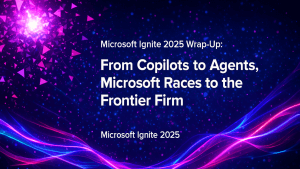Microsoft Ignite 2025 was not framed as another feature release cycle, but rather the moment that Microsoft fully committed to Agentic AI as the next platform layer. Across the briefings, keynotes, technical sessions, and partner announcements, Microsoft repeatedly emphasized one core idea: AI is no longer an add-on. It is the operating system for modern enterprise work.
That shift wasn’t subtle. It shaped how Microsoft described cloud operations, how developers should build software, how data should be modeled, how security should function, and even how organizations should structure themselves. The tone across Ignite was confident, fast-moving, and unambiguously anchored in the belief that enterprises are entering (and must prepare for!) an “Agentic Era.”
A Unified Vision Emerges Across the Pre-Briefings
From the earliest pre-briefings, Microsoft clearly wanted analysts to recognize a throughline across its products: unification. Unification of data through Fabric and OneLake. Unification of agent development through Foundry. Unification of security and governance through Agent 365. And unification of the entire end-user experience through Work IQ and Microsoft 365 Copilot.
At the time, those threads felt like a strategic setup. Once Ignite began, it became obvious: Microsoft wasn’t hinting at convergence; the company was declaring it.
Ignite’s message reinforced that the “Frontier Firm” is not an abstract goal. It’s the operating model Microsoft expects organizations to adopt, where humans and AI agents collaborate continuously, with governance embedded rather than bolted on.
Work IQ, Fabric IQ, and Foundry IQ: Microsoft’s New Intelligence Fabric
One of the strongest undercurrents at Ignite was the way Microsoft repositioned its “IQ layers.” What could easily have come across as branding instead felt like Microsoft sketching a blueprint for the next decade of enterprise AI.
Work IQ, powering Microsoft 365 Copilot, made the biggest leap. Ignite showed how deeply Microsoft believes in blending organizational knowledge with individual work patterns. When the team described Work IQ as knowing “your work chart, not just your org chart,” it reflected a broader ambition: making AI genuinely context-aware inside real workflows.
What stood out to us was how seamlessly Work IQ now extends to custom agents, not just Copilot itself. Builders can now tap into that same data layer through Copilot Studio or APIs. In many ways, that shifts M365 from “office suite” to “organizational memory and inference engine.”
While Work IQ grounds agents in human behavior, Fabric IQ gives them business meaning. Fabric’s semantic models, ontologies, and real-time data flows are starting to look like a digital nervous system that agent fleets can reason across. Additionally, because those models sit atop OneLake shortcuts, mirroring, and multi-cloud connectivity, Microsoft is positioning Fabric as a flexible path forward for organizations with heterogeneous data estates.
Finally, Foundry IQ connects everything. Ignite positioned Foundry IQ as a fully managed knowledge system: not a RAG pipeline, not a connector library, but a reasoning layer that spans Work IQ, Fabric IQ, operational data, internal systems, and the open web. During the event, Microsoft really pushed the idea that IQ-based retrieval will replace a patchwork of custom glue that organizations have been building manually.
The cumulative effect: Microsoft wants organizations to stop thinking about knowledge access as an engineering effort and instead treat it as a built-in property of the platform. That perspective aligns with where the market is heading and where enterprises are struggling.
Foundry as the New Platform Layer for Agents
Microsoft’s Foundry pre-brief hinted at this shift, but Ignite solidified it: Microsoft Foundry is no longer a developer tool. It is now the platform Microsoft wants enterprises to build agents on.
Developers I spoke with at the conference saw three meaningful changes:
- A unified model API with a Model Router that finally reduces model selection risk.
- A broadened fine-tuning and synthetic data toolkit that allows teams to iterate faster, even without perfect datasets.
- Foundry Local, which resonated strongly with regulated and edge-heavy industries that want to run agents offline.
The real turning point, however, is the Foundry Control Plane. When developers toggle on Purview, Defender, or Entra protections directly inside Foundry, agent governance becomes part of the build-from-day-one process. This is something that many enterprise teams have been missing.
By integrating Foundry into GitHub and VS Code, Microsoft also anchored Agentic AI directly into daily developer workflows. Ignite sessions showed developers building agents, defining plans, validating safety checks, and pushing code through GitHub pipelines without ever leaving their IDE. That workflow cohesion is a competitive advantage.
The vibe from attendees echoed the same feeling I had: this is Azure all over again, but the “compute unit” isn’t VMs. It’s agents.
Azure Copilot and the Shift Toward Agentic Cloud Operations
A major Ignite theme was that cloud operations are moving from dashboards to agents. Azure Copilot—already a prominent feature in the pre-brief—graduated into a fully agentic operations experience.
What resonated most wasn’t the individual agents (such as migration, deployments, observability, optimization, resiliency, troubleshooting) but the orchestrator behind them. Azure Copilot deciding which agent to call based on context felt subtly transformative. Operations teams no longer need to think in terms of tools but in terms of intent.
Azure Copilot walked through complex migrations, generated Terraform templates, surfaced anomalies, traced performance regressions, and proposed fixes with a clarity that felt production-ready.
The addition of “bring your own storage” for Copilot history and artifacts also landed well with regulated sectors. Banks and public-sector customers immediately recognized the importance of controlling data retention when agents participate in operations workflows.
Windows 365 for Agents and Ask Copilot on the taskbar expanded that model across devices. The idea that agents can run on secure, policy-controlled Cloud PCs, and be streamed anywhere, made the concept feel practical, not theoretical.
Fabric, OneLake, and the Reality of an AI-Ready Data Estate
Fabric had one of the strongest receptions of the event, not due to the flashy features, but because it presented a clear, pragmatic roadmap for unifying analytics, operational data, and AI.
Fabric IQ now sits alongside Fabric’s semantic models and real-time capabilities, giving AI agents the missing ingredient: business meaning. During Ignite sessions, Microsoft showed how agents operating in Fabric IQ could interpret time-series, operational, and geospatial data within the context of the business entities that matter, such as orders, customers, assets, and flights.
What struck us was how much multi-cloud Fabric has become. OneLake’s shortcuts and mirroring now make Azure feel less like a destination and more like a hub. Teams using Snowflake, Azure SQL MI, BigQuery, Oracle, or SAP can all feed into Fabric IQ in a way that doesn’t feel forced.
The Tessell announcement reinforced that trend. Their ability to modernize Oracle on Azure without schema changes and to continuously stream changes into Fabric and OneLake matched the conversations happening across the show floor. Organizations want modernization paths that don’t require rewriting the world.
Agent 365, Security Copilot, and the Push for Ambient Defense
Security messaging at Ignite felt like a continuation of our pre-briefing insights. Microsoft is treating Agentic AI as a security primitive, not a technology requiring separate security solutions.
Agent 365 became the centerpiece. It wasn’t pitched as a tool; it was pitched as the control plane for the next decade of identity and governance. The idea that agents should onboarded, authenticated, and governed like employees resonated with CISOs and IT leaders across the event.
Seeing Entra Agent ID, Purview data safeguards, and Defender threat detection all tied directly into a unified agent registry made the concept feel less theoretical and more operationally grounded. Security Copilot being included for all Microsoft 365 E5 customers added momentum. It signaled that Microsoft wants AI-first security to become the norm across enterprise security teams, not a premium add-on.
Predictive Shielding also stood out. By using graph-based knowledge to anticipate where attackers might go next, Defender is beginning to mirror the same “agentic thinking” that the rest of Microsoft’s stack is adopting.
Together, these announcements suggest that the next generation of enterprise security will be defined not by dashboards, but by autonomous defense across agent fleets, user identities, and data systems.
M365 Copilot, Low-Code, and the Reality of Agents in Everyday Work
The Ignite updates to Microsoft 365 Copilot and low-code workflows reinforced a broader trend: agents are becoming everyday teammates, not special-purpose assistants. Agent Mode in Word, Excel, and PowerPoint made this explicit. These aren’t chatbots that write drafts; they’re structured collaborators that work iteratively with users. Adding voice interactions from the mobile app, new workflow automations, and Teams-based facilitator agents emphasized how agents are moving into the flow of human work.
The low-code story felt especially synchronized with Ignite’s themes. Power Apps’ AI-first maker experience, one where agents guide data modeling, requirements, architecture, and logic, showed how Microsoft plans to democratize application creation in a responsible way. Additionally, the Model Context Protocol (MCP) updates tied it all together, enabling agents to operate existing applications, not just new ones. Seeing Power Apps exposed as MCP endpoints for agents to use was a key turning point. It bridged Microsoft’s “apps” story with its “agents” story in a way that felt natural.
What Ignite 2025 Means for Enterprise Teams
Across the event, a consistent sentiment emerged: AI is no longer optional or experimental. Organizations are now expected to manage fleets of agents, integrate shared intelligence layers, unify data meaning, and support responsible deployment paths across hybrid environments.
Teams are not being asked to abandon existing tools. Instead, they’re being pushed to incorporate agents into those tools and treat governance as a core function rather than a later step.
Ignite 2025 made clear that the winners in the Agentic Era will be the organizations that can operationalize agents, not merely build them. Those who master unified data, strong governance, and agent-aware workflows will gain a meaningful advantage over those still navigating siloed tools and bespoke pipelines.
Looking Ahead
Ignite left us with a strong sense of where Microsoft is steering the enterprise ecosystem. The company envisions a world where:
- Agents are the primary interface for cloud, data, and productivity.
- Intelligence layers replace complex integration efforts.
- Security is ambient and autonomous.
- Development shifts from static application architectures to dynamic agent workflows.
- Frontier Firms use agents not just for automation, but for creativity, insight, and decision-making.
Ignite 2025 wasn’t a story about tools. It was a story about how enterprises will work. And Microsoft’s message was unmistakable: the next era belongs to those who can operate at agent scale.



